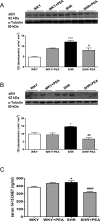Palmitoylethanolamide treatment reduces blood pressure in spontaneously hypertensive rats: involvement of cytochrome p450-derived eicosanoids and renin angiotensin system
- PMID: 25951330
- PMCID: PMC4423982
- DOI: 10.1371/journal.pone.0123602
Palmitoylethanolamide treatment reduces blood pressure in spontaneously hypertensive rats: involvement of cytochrome p450-derived eicosanoids and renin angiotensin system
Abstract
Palmitoylethanolamide (PEA), a peroxisome proliferator-activated receptor-α agonist, has been demonstrated to reduce blood pressure and kidney damage secondary to hypertension in spontaneously hypertensive rat (SHR). Currently, no information is available concerning the putative effect of PEA on modulating vascular tone. Here, we investigate the mechanisms underpinning PEA blood pressure lowering effect, exploring the contribution of epoxyeicosatrienoic acids, CYP-dependent arachidonic acid metabolites, as endothelium-derived hyperpolarizing factors (EDHF), and renin angiotensin system (RAS) modulation. To achieve this aim SHR and Wistar-Kyoto rats were treated with PEA (30 mg/kg/day) for five weeks. Functional evaluations on mesenteric bed were performed to analyze EDHF-mediated vasodilation. Moreover, mesenteric bed and carotid were harvested to measure CYP2C23 and CYP2J2, the key isoenzymes in the formation of epoxyeicosatrienoic acids, and the soluble epoxide hydrolase, which is responsible for their degradation in the corresponding diols. Effect of PEA on RAS modulation was investigated by analyzing angiotensin converting enzyme and angiotensin receptor 1 expression. Here, we showed that EDHF-mediated dilation in response to acetylcholine was increased in mesenteric beds of PEA-treated SHR. Western blot analysis revealed that the increase in CYP2C23 and CYP2J2 observed in SHR was significantly attenuated in mesenteric beds of PEA-treated SHR, but unchanged in the carotids. Interestingly, in both vascular tissues, PEA significantly decreased the soluble epoxide hydrolase protein level, accompanied by a reduced serum concentration of its metabolite 14-15 dihydroxyeicosatrienoic acid, implying a reduction in epoxyeicosatrienoic acid hydrolisis. Moreover, PEA treatment down-regulated angiotensin receptor 1 and angiotensin converting enzyme expression, indicating a reduction in angiotensin II-mediated effects. Consistently, a damping of the activation of angiotensin receptor 1 underlying pathways in mesenteric beds was shown in basal conditions in PEA-treated SHR. In conclusion, our data demonstrate the involvement of epoxyeicosatrienoic acids and renin angiotensin system in the blood pressure lowering effect of PEA.
Conflict of interest statement
Figures





Similar articles
-
N-Palmitoylethanolamide protects the kidney from hypertensive injury in spontaneously hypertensive rats via inhibition of oxidative stress.Pharmacol Res. 2013 Oct;76:67-76. doi: 10.1016/j.phrs.2013.07.007. Epub 2013 Aug 2. Pharmacol Res. 2013. PMID: 23917217
-
Changes in endothelium-derived hyperpolarizing factor in hypertension and ageing: response to chronic treatment with renin-angiotensin system inhibitors.Clin Exp Pharmacol Physiol. 2004 Sep;31(9):650-5. doi: 10.1111/j.1440-1681.2004.04054.x. Clin Exp Pharmacol Physiol. 2004. PMID: 15479174
-
Enalapril treatment alters the contribution of epoxyeicosatrienoic acids but not gap junctions to endothelium-derived hyperpolarizing factor activity in mesenteric arteries of spontaneously hypertensive rats.J Pharmacol Exp Ther. 2009 Aug;330(2):413-22. doi: 10.1124/jpet.109.152116. Epub 2009 May 1. J Pharmacol Exp Ther. 2009. PMID: 19411610 Free PMC article.
-
A developmental genetic mechanism involving angiotensin in spontaneously hypertensive rats.Clin Exp Pharmacol Physiol Suppl. 1992;19:19-22. doi: 10.1111/j.1440-1681.1992.tb02805.x. Clin Exp Pharmacol Physiol Suppl. 1992. PMID: 1395112 Review.
-
Is there a role for the vascular renin-angiotensin system in the determination of vascular structure?Blood Vessels. 1991;28(1-3):224-30. doi: 10.1159/000158866. Blood Vessels. 1991. PMID: 2001473 Review.
Cited by
-
Cannabinoids in arterial, pulmonary and portal hypertension - mechanisms of action and potential therapeutic significance.Br J Pharmacol. 2019 May;176(10):1395-1411. doi: 10.1111/bph.14168. Epub 2018 Apr 14. Br J Pharmacol. 2019. PMID: 29455452 Free PMC article. Review.
-
Comprehensive mini-review: therapeutic potential of cannabigerol - focus on the cardiovascular system.Front Pharmacol. 2025 Mar 26;16:1561385. doi: 10.3389/fphar.2025.1561385. eCollection 2025. Front Pharmacol. 2025. PMID: 40206058 Free PMC article. Review.
-
Endothelium-Derived Hyperpolarizing Factors: A Potential Therapeutic Target for Vascular Dysfunction in Obesity and Insulin Resistance.Diabetes. 2016 Aug;65(8):2118-20. doi: 10.2337/dbi16-0026. Diabetes. 2016. PMID: 27456617 Free PMC article. No abstract available.
-
Palmitoylethanolamide, an endogenous fatty acid amide, and its pleiotropic health benefits: A narrative review.J Biomed Res. 2024 Oct 22;39(3):215-228. doi: 10.7555/JBR.38.20240053. J Biomed Res. 2024. PMID: 39433509 Free PMC article.
-
Cross-Talk between the (Endo)Cannabinoid and Renin-Angiotensin Systems: Basic Evidence and Potential Therapeutic Significance.Int J Mol Sci. 2022 Jun 6;23(11):6350. doi: 10.3390/ijms23116350. Int J Mol Sci. 2022. PMID: 35683028 Free PMC article. Review.
References
-
- Spieker LE, Lüscher TF. Protection of endothelial function. In: Handbook of Experimental Pharmacology. 2005;170: 619–644. - PubMed
-
- Campbell WB, Gebremedhin D, Pratt PF, Harder DR. Identification of epoxyeicosatrienoic acids as endothelium-derived hyperpolarizing factors. Circ Res. 1996;78: 415–423. - PubMed
-
- Nishikawa Y, Stepp DW, Chilian WM. In vivo location and mechanism of EDHF-mediated vasodilation in canine coronary microcirculation. Am J Physiol. 1999;277: 1252–1259. - PubMed
-
- Honing ML, Smits P, Morrison PJ, Rabelink TJ. Bradykinin induced vasodilation of human forearm resistance vessels is primarily mediated by endothelium-dependent hyperpolarization. Hypertension. 2000;35: 1314–1318. - PubMed
Publication types
MeSH terms
Substances
LinkOut - more resources
Full Text Sources
Other Literature Sources
Medical

